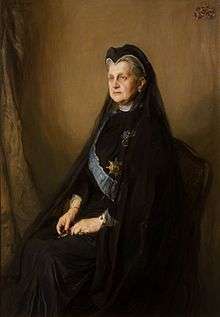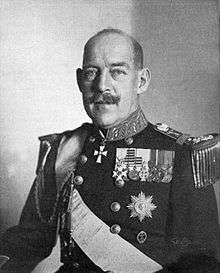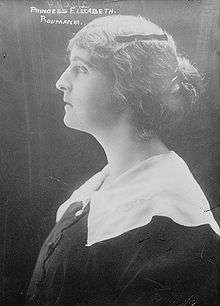Monarchy of Greece
| Monarchy of Greece | |
|---|---|
 | |
 Constantine II | |
| Details | |
| Style | His Majesty |
| First monarch |
Otto I (as King of Greece) |
| Last monarch |
Constantine II (as King of the Hellenes) |
| Formation | 27 May 1832 |
| Abolition | 1 June 1973[1] |
| Residence | List |
| Appointer | Hereditary |
| Pretender(s) | Constantine II |
The Monarchy of Greece (Greek: Μοναρχία της Ελλάδας) or Greek Monarchy (Ελληνική Μοναρχία) was the government in which a hereditary monarch was the sovereign of the Kingdom of Greece from 1832 to 1924 and 1935 to 1973.
History
The Monarch of Greece was created by the London Conference of 1832 at which the First Hellenic Republic was abolished.
In 1832 Prince Otto of Bavaria of the House of Wittelsbach was styled Otto I, King of Greece which he reigned for 30 years until he was deposed in 1862.
A head of state referendum was held in 1862 to name a new King. Most of the Greek people wanted Prince Alfred, Duke of Edinburgh to be the new King. He won the referendum by 230,016 against the Duke of Leuchtenberg. Alfred declined to be King, and so did every candidate until Prince William of Denmark of the House of Glücksburg who received six votes. William was elected unanimously by the Greek Assembly, and became George I, King of the Hellenes.
There was a referendum in 1920 to restore Constantine I as monarch, but four years later the Second Hellenic Republic was established and the monarchy was abolished following a referendum in 1924. Then in 1935 the Monarchy was restored after a referendum and maintained after a referendum in 1946.
Greece was at threat during 1946, as the USSR had invaded them following the break in the agreement at the Yalta Conference.
In 1973 the Greek military junta called a referendum in 1973, which abolished the Monarchy for the second time in Greek history. Then in 1974, the Prime Minister Konstantinos Karamanlis called a referendum in 1974 which formally abolished the Monarchy.
Residences
Tatoi was the private residence and 10,000-acre estate outside of Athens originally bought by King George I in the 1870s. The property was seized by the Republic following the 1974 referendum and has long been a contentious issue between the former Royal Family and the Greek state.
List of Greek monarchs
| Monarch | Consort | Reign | Royal House | ||||
|---|---|---|---|---|---|---|---|
| # | Portrait | Name | Portrait | Name | Reign start | Reign end | |
| 1 |  |
King Otto I (1815–1867) Όθων |
 |
Queen Amalia (1818–1875) Αμαλία |
27 May 1832 [2] |
23 October 1862 (Deposed) |
House of Wittelsbach |
| 2 |  |
King George I (1845–1913) Γεώργιος Α' |
 |
Queen Olga (1851–1926) Όλγα |
30 March 1863 | 18 March 1913 | House of Glücksburg |
| 3 |  |
King Constantine I (1868–1923) Κωνσταντίνος Α' |
 |
Queen Sophia (1870–1932) Σοφία |
18 March 1913 | 11 June 1917 (Abdicated) |
House of Glücksburg |
| 4 |  |
King Alexander I (1893–1920) Αλέξανδρος Α' |
 |
Princess Aspasia (1896–1972) Ασπασία [3] |
11 June 1917 | 25 October 1920 | House of Glücksburg |
| (3) |  |
King Constantine I (1868–1923) Κωνσταντίνος Α' |
 |
Queen Sophia (1870–1932) Σοφία |
19 December 1920 | 27 September 1922 (Abdicated) |
House of Glücksburg |
| 5 |  |
King George II (1890–1947) Γεώργιος Β΄ |
 |
Queen Elisabeth (1894–1956) Ελισάβετ |
27 September 1922 | 25 March 1924 (Deposed) |
House of Glücksburg |
| Second Hellenic Republic | |||||||
| (5) |  |
King George II (1890–1947) Γεώργιος Β΄ |
Divorced | 3 November 1935 | 1 April 1947 | House of Glücksburg | |
| 6 |  |
King Paul I (1901–1964) Παύλος Α' |
 |
Queen Frederica (1917–1981) Φρειδερίκη |
1 April 1947 | 6 March 1964 | House of Glücksburg |
| 7 |  |
King Constantine II (b. 1940) Κωνσταντίνος Β΄ |
 |
Queen Anne-Marie (b. 1946) Άννα-Μαρία |
6 March 1964 | 1 June 1973 (Deposed) |
House of Glücksburg |
Royal consorts
- Duchess Amalia of Oldenburg, Princess of Holstein-Gottorp (wife of King Otto)
- Grand Duchess Olga Constantinovna of Russia (wife of King George I)
- Princess Sophia of Prussia (wife of King Constantine I)
- Miss Aspasia Manos (wife of King Alexander)
- Princess Elisabeth of Romania (wife of King George II)
- Princess Frederica of Hanover, Great Britain and Ireland (wife of King Paul)
- Princess Anne-Marie of Denmark (wife of King Constantine II)
Regents of Greece
Insignia
 Monogram of Otto I
Monogram of Otto I Monogram of George I
Monogram of George I Monogram of Constantine I
Monogram of Constantine I Monogram of Alexander I
Monogram of Alexander I Monogram of George II
Monogram of George II Monogram of Paul I
Monogram of Paul I Monogram of Constantine II
Monogram of Constantine II
See also
| Wikimedia Commons has media related to Monarchs of Greece. |
References
- ↑ The Junta had already staged a plebiscite held on 29 July 1973, which resulted in the establishment of the Republic. However, after the fall of the military regime, the new government, under Constantine Karamanlis, decided to hold another one, as Junta legal acts were considered illegal.
- ↑ Protocol signed in 1832 but landed in Greece on 6 February 1833
- ↑ Aspasia and Alexander's marriage was kept secret, and Aspasia was never styled as Queen of the Hellenes. Sometime after Alexander's death she was recognized as a Princess of Greece and Denmark instead.
.svg.png)